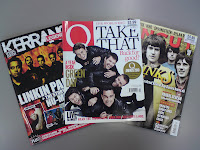Lucy Carballo
Candidate Number :- 6046
After we had completed our first music video to our chosen song, “Jump”, we handed out a form for our peer reviewers to fill out and comment on what they thought about the video. We asked them to comment on important factors such as whether they feel there was a variety of shots and angles, whether the lighting was ok, and the general video quality – whether it is blurred at all.
Candidate Number :- 6046
After we had completed our first music video to our chosen song, “Jump”, we handed out a form for our peer reviewers to fill out and comment on what they thought about the video. We asked them to comment on important factors such as whether they feel there was a variety of shots and angles, whether the lighting was ok, and the general video quality – whether it is blurred at all.
From the results, we received back from our peer reviewers, we learnt that the stop motion we had placed near the beginning of the video was enjoyed by all, and they thought it was different and added uniqueness to the video, but they found that the second stop motion clip was a bit too long with not enough going on, so we had to look into improving that. We also were told that we didn’t have enough variety in the editing and amount of different angles. However our biggest problem was the lip syncing.
Our main actor Thomas Rivera has lived in Canada for many years, and has a mild Canadian accent. This results in the words he is saying looks slightly out of place at times. It did not occur to any of us about Tom’s accent, but looking closely at the video all we had to do was move Tom’s lips a frame down to make it at the right point. We also had to re-do some of the scenes of Tom actually singing, rather than lip syncing, to make his lips more clearer.
After we had received all the results back from our first draft, we sat down as a group and went through our video stating improvements we could make linked to the improvements stating by our peer reviewers. We added more special effects, and added more images during the stop motion. We then handed out the same sheets to our class members to review our second draft.
From our new feedback we had successfully rectified the lip syncing problem with everyone commenting on the improvement we had made to it. They also liked our new effects and images we had placed into our music video, but mainly they liked the changes we had down to the stop motion in the middle of the music video which they didn’t like in our first draft. We placed images of a drummer hitting drums to the beat of the song, which also links to our genre of soft rock. We were very happy with our final draft and so were our peer reviewers.
































